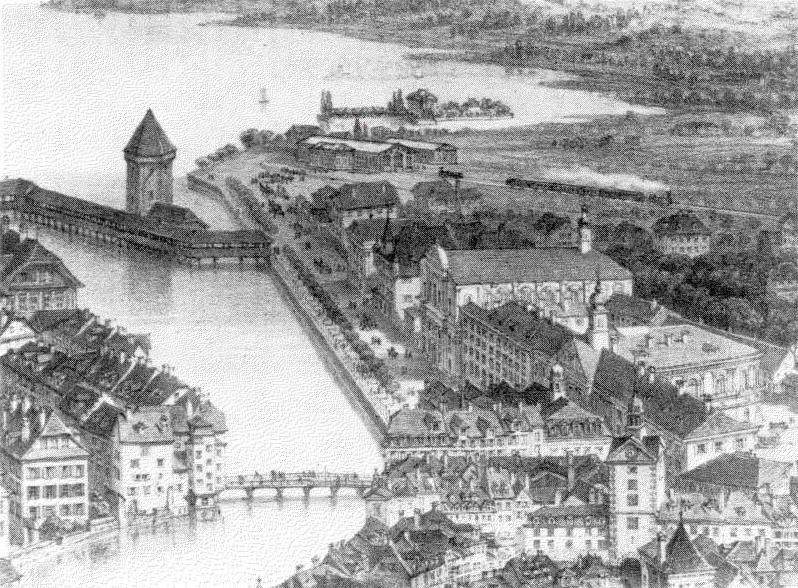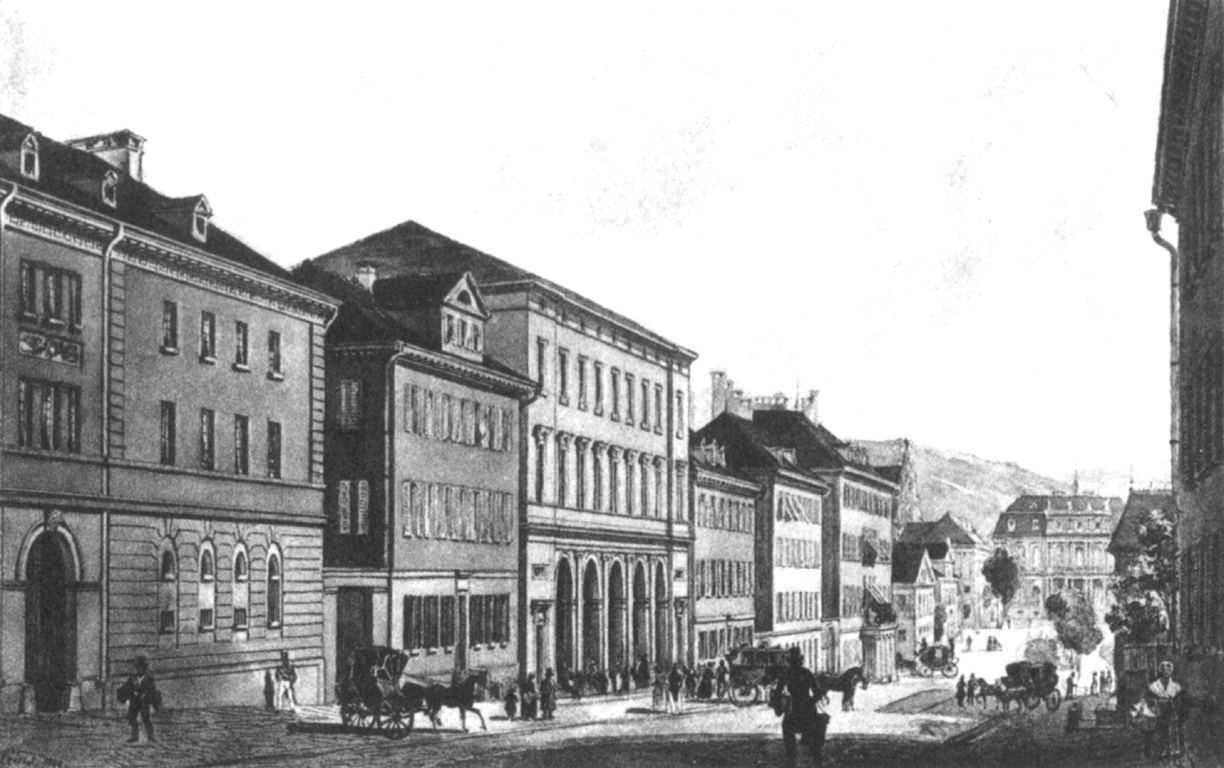|
Carl Etzel
Karl von Etzel (old spelling Carl von Etzel; 6 January 1812 – 2 May 1865) was a German railway engineer and architect. He created many famous railway lines, bridges and viaducts, including the Bietigheim Enz Valley Viaduct. Life Karl Etzel was the son of the Stuttgart city planner Gottlieb Christian Eberhard von Etzel, the builder of the Neuen Weinsteige, a picturesque road in southeastern Stuttgart. Because his father had built houses in Heilbronn for the Rauch and Mertz families in 1811–1812, it was commonly believed that he was born in Heilbronn, but his birth is registered in the parish register of Stuttgart. The young Etzel studied from 1831 to 1835 with Nikolaus Friedrich von Thouret. In 1835 Karl von Etzel worked on construction projects in France, including the Paris ( Saint-Lazare)– Saint-Germain railway with the bridge over the Seine at Asnières (destroyed during the February Revolution of 1848 and later rebuilt). In 1837 he was the Chief Engineer for the c ... [...More Info...] [...Related Items...] OR: [Wikipedia] [Google] [Baidu] |
Württemberg
Württemberg ( ; ) is a historical German territory roughly corresponding to the cultural and linguistic region of Swabia. The main town of the region is Stuttgart. Together with Baden and Hohenzollern, two other historical territories, Württemberg now forms the Federal State of Baden-Württemberg. Württemberg was formerly also spelled Würtemberg and Wirtemberg. History Originally part of the old Duchy of Swabia, its history can be summarized in the following periods: *County of Württemberg (1083–1495) * Duchy of Württemberg (1495–1803) *Electorate of Württemberg (1803–1806) *Kingdom of Württemberg (1806–1918) *Free People's State of Württemberg (1918–1945) After World War II, it was split into Württemberg-Baden and Württemberg-Hohenzollern due to the different occupation zones of the United States and France. Finally, in 1952, it was integrated into Baden-Württemberg. Stuttgart, the historical capital city of Württemberg, became the capital of the p ... [...More Info...] [...Related Items...] OR: [Wikipedia] [Google] [Baidu] |
1865 Deaths
Events January–March * January 4 – The New York Stock Exchange opens its first permanent headquarters at 10-12 Broad near Wall Street, in New York City. * January 13 – American Civil War : Second Battle of Fort Fisher: United States forces launch a major amphibious assault against the last seaport held by the Confederates, Fort Fisher, North Carolina. * January 15 – American Civil War: United States forces capture Fort Fisher. * January 31 ** The Thirteenth Amendment to the United States Constitution (conditional prohibition of slavery and involuntary servitude) passes narrowly, in the House of Representatives. ** American Civil War: Confederate General Robert E. Lee becomes general-in-chief. * February ** American Civil War: Columbia, South Carolina burns, as Confederate forces flee from advancing Union forces. * February 3 – American Civil War : Hampton Roads Conference: Union and Confederate leaders discuss peace terms. * February 8 & ... [...More Info...] [...Related Items...] OR: [Wikipedia] [Google] [Baidu] |
1812 Births
Year 181 ( CLXXXI) was a common year starting on Sunday (link will display the full calendar) of the Julian calendar. At the time, it was known as the Year of the Consulship of Aurelius and Burrus (or, less frequently, year 934 ''Ab urbe condita''). The denomination 181 for this year has been used since the early medieval period, when the Anno Domini calendar era became the prevalent method in Europe for naming years. Events By place Roman Empire * Imperator Lucius Aurelius Commodus and Lucius Antistius Burrus become Roman Consuls. * The Antonine Wall is overrun by the Picts in Britannia (approximate date). Oceania * The volcano associated with Lake Taupō in New Zealand erupts, one of the largest on Earth in the last 5,000 years. The effects of this eruption are seen as far away as Rome and China. Births * April 2 – Xian of Han, Chinese emperor (d. 234) * Zhuge Liang, Chinese chancellor and regent (d. 234) Deaths * Aelius Aristides, Greek orator and w ... [...More Info...] [...Related Items...] OR: [Wikipedia] [Google] [Baidu] |
German Civil Engineers
German(s) may refer to: * Germany (of or related to) **Germania (historical use) * Germans, citizens of Germany, people of German ancestry, or native speakers of the German language ** For citizens of Germany, see also German nationality law **Germanic peoples (Roman times) * German language **any of the Germanic languages * German cuisine, traditional foods of Germany People * German (given name) * German (surname) * Germán, a Spanish name Places * German (parish), Isle of Man * German, Albania, or Gërmej * German, Bulgaria * German, Iran * German, North Macedonia * German, New York, U.S. * Agios Germanos, Greece Other uses * German (mythology), a South Slavic mythological being * Germans (band), a Canadian rock band * German (song), "German" (song), a 2019 song by No Money Enterprise * ''The German'', a 2008 short film * "The Germans", an episode of ''Fawlty Towers'' * ''The German'', a nickname for Congolese rebel André Kisase Ngandu See also * Germanic (disambi ... [...More Info...] [...Related Items...] OR: [Wikipedia] [Google] [Baidu] |
Stuttgart-Bad Cannstatt Station
Bad Cannstatt station is the second largest station of the German city of Stuttgart after Stuttgart Hauptbahnhof and has eight platform tracks. Together with Untertürkheim station, it is the oldest station in Württemberg. History During the planning of the original railway in Württemberg, the Württemberg Central Railway (german: Württembergische Centralbahn), it was proposed to provide a station for the city of Cannstatt with its 5,500 inhabitants. The original proposal for the line consisted of a connection between the proposed Stuttgart Central Station to Cannstatt, where it would branch towards Esslingen and Ludwigsburg. Because of Stuttgart's geographical location, the route via Cannstatt was the only feasible route for a railway with the technology of the time. On 5 October 1845, the first railway in Württemberg was opened from Cannstatt to Untertürkheim. Following the completion of the Rosenstein Tunnel on 4 July 1846, the first train ran into Stuttgart station on ... [...More Info...] [...Related Items...] OR: [Wikipedia] [Google] [Baidu] |
Linz
Linz ( , ; cs, Linec) is the capital of Upper Austria and third-largest city in Austria. In the north of the country, it is on the Danube south of the Czech border. In 2018, the population was 204,846. In 2009, it was a European Capital of Culture. Geography Linz is in the centre of Europe, lying on the Paris–Budapest west–east axis and the Malmö–Trieste north–south axis. The Danube is the main tourism and transport connection that runs through the city. Approximately 29.27% of the city's wide area is grassland. A further 17.95% are covered with forest. All the rest areas fall on water (6.39%), traffic areas and land. Districts Since January 2014 the city has been divided into 16 statistical districts: Before 2014 Linz was divided into nine districts and 36 statistical quarters. They were: #Ebelsberg #Innenstadt: Altstadtviertel, Rathausviertel, Kaplanhofviertel, Neustadtviertel, Volksgartenviertel, Römerberg-Margarethen #Kleinmünchen: Kleinmünchen, Neue ... [...More Info...] [...Related Items...] OR: [Wikipedia] [Google] [Baidu] |
Hauenstein Railway Line
The Hauenstein Railway is a major railway line in Switzerland connecting the cities of Basel and Olten. The original line was built between 1853 and 1858 under the Unterer Hauenstein Pass, an ancient pass through the Jura Mountains, including a long tunnel under the village of Hauenstein. Between 1912 and 1916 a new line with an long base tunnel was built further east, by-passing the steeper sections of the line. Normally long-distance trains use the base tunnel line, and the old summit line is only used by trains serving the local people ('' Läufelfingerli''). Sometimes during disruptions inter-city trains operate on the old line, but it is reasonably fast and diverted trains take only about four minutes longer than normal services. Freight trains rarely use the summit line because of its large gradients. Hauenstein summit tunnel The first railway in Switzerland was the extension of the French Strasbourg–Basel Railway (French: ''Chemin de fer de Strasbourg à Bâle'') fr ... [...More Info...] [...Related Items...] OR: [Wikipedia] [Google] [Baidu] |
Swiss Central Railway
The Swiss Central Railway (''Schweizerische Centralbahn''; SCB or S.C.B.) was one of the five major private railway companies of Switzerland. The SCB with a track length of 332 kilometres was integrated into the Swiss Federal Railways (SBB) in 1902. History The SCB based in Basel was founded on 4 February 1853 by Johann Jakob Speiser, Achilles Bischoff and Karl Geigy. The shares were mainly owned by Parisian banks. But Basel banks and the cantons of Basel-Stadt and Basel-Landschaft were also involved. The issue of shares worth Swiss Francs (CHF) 36 million and bonds worth CHF 12 million were planned. Speculation on the Paris stock exchange, however, led to a sharp fall in prices. Thus, the value of the SCB shares fell from CHF 500 to 200 and the share capital finally amounted to only CHF 14.5 million. The cantons of Luzern and Bern and Bernese municipalities rescued the company by buying shares and subsidies totaling CHF 6 million. The main goal of the SCB was the cons ... [...More Info...] [...Related Items...] OR: [Wikipedia] [Google] [Baidu] |
Stuttgart Central Station
Stuttgart Hauptbahnhof (; en, Stuttgart central station) is the primary railway station in the city of Stuttgart, the state capital of Baden-Württemberg, in southwestern Germany. It is the largest regional and long-distance railway station in Stuttgart, the main node of the Stuttgart S-Bahn network, and, together with the station at Charlottenplatz, it is the main node of the Stuttgart Stadtbahn. Located at the northeastern end of the ''Königstraße'', the main pedestrian zone of the city centre, the main line station is a terminus, whilst the subterranean S-Bahn and Stadtbahn stations are through-stations. The station is well known for its 12-storey tower with a large, rotating and illuminated Mercedes-Benz star insignia on top; the tower and station building are city landmarks. Plans for the controversial Stuttgart 21 project to convert the main line terminus station into an underground through station include the demolition of the side wings of the building, together wi ... [...More Info...] [...Related Items...] OR: [Wikipedia] [Google] [Baidu] |
Geislinger Steige
The Geislinger Steige ("Geislingen climb") is an old trade route over the low mountain range of the Swabian Jura in southern Germany. It links Geislingen an der Steige with Amstetten and is one of the most famous ascents in the Jura. The name "Geislinger Steige" refers both to: * The long-distance road between Geislingen an der Steige and Amstetten that has existed since Roman times and, today, is part of the B 10 road. * The railway ramp forming part of the '' Filstalbahn'', a section of the main line between Munich and Stuttgart The ramp is 5.6 km long and climbs a height of 112 m. It has an incline of 1:44.5, which is 22.5 ‰ or 2.25%. The curve radius in places is less than 300 m, with a minimum of 278 m. This section of the line is therefore built in accordance with the standards for mountain railways.Geschichtsverein Geislingen, S. 89 Planning and Construction With the passing of the ''law affecting the construction of railways'' in 1843, the ... [...More Info...] [...Related Items...] OR: [Wikipedia] [Google] [Baidu] |





